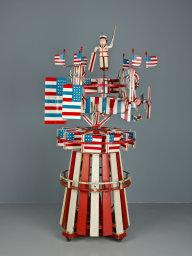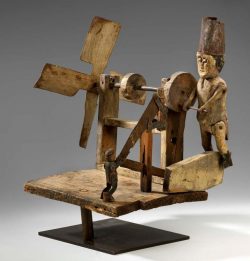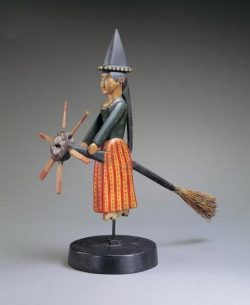
American Flag Whirligig, mid 20th-century
Artist unidentified
Painted iron and carved and painted wood
Smithsonian American Art Museum
“English-speakers, and particularly children, began spinning whirligigs as early as the 15th century. Since then, “whirligig” has acquired several meanings beyond its initial toy sense. It even has a place in the common name of the whirligig beetle, a member of the family Gyrinidae that swiftly swims in circles on the surface of still water. The word whirligig comes to us from Middle English “whirlegigg” which is itself from whirlen, meaning “to whirl,” and gigg, meaning “(toy) top.”

Whirligig, 1939/45
Frank Memkus, American, 1884-1965
Painted wood and metal
Art Institute of Chicago, Permanent Collection
“Whirligigs, three-dimensional, wind-driven articulated toys, have been created by artists, self-taught and otherwise, for more than 200 years in this country. In the book ”Folk Art in American Life,” by Jacqueline Atkins and Robert Bishop (Viking Studio, 1995), the authors . . . .distinguish the weather vane from the whirligig. They write: ”These small, animated statues or structures were created strictly for amusement, for, unlike weather vanes, they do no more than signal that the wind is blowing or not blowing. They also allow a great deal of scope
for creative expression.”

Whirligig with Men Sawing Wood, c. 1900
Artist unidentified
Carved and painted wood with metal
Smithsonian American Art Museum
The authors write that no 18th-century examples seemed to have survived, but that whirligigs were ubiquitous by the 19th century. They quote a reference to one in Washington Irving’s ”Legend of Sleepy Hollow,” from 1819: ”Thus, while the busy dame bustled about the house, or plied her spinning wheel at one end of the piazza, honest Balt did sit smoking his evening pipe at the other, watching the achievements of a little wooden warrior, who, armed with a sword in each hand, was most valiantly fighting the wind on the pinnacle of the barn.”

Witch on a Broomstick Whirligig
Late 19th-century, New England
Artist unidentified
Paint on wood with twigs and metal
American Folk Art Museum
There are a few outstanding collections of whirligigs in museums in this country, notably the Smithsonian, the Abby Aldrich Rockefeller Collection at Colonial Williamsburg, and the Shelburne Museum, in Shelburne, Vt. The Shelburne boasts a whirligig trade sign: A woman seated at a spinning wheel moves her foot up and down on the treadle as the wind turns the wheel. . . . Whirligigs appeal to contemporary artists, who tend to label
them kinetic sculpture.”
Sources:
Definition from the online Merriam-Webster Dictionary
Excerpt: “Animation Meets Charm In Whirligigs”
by Wendy Moonan,
The New York Times, August 14, 1998
Betts Bulletin Editor: Allison Gray Sanders